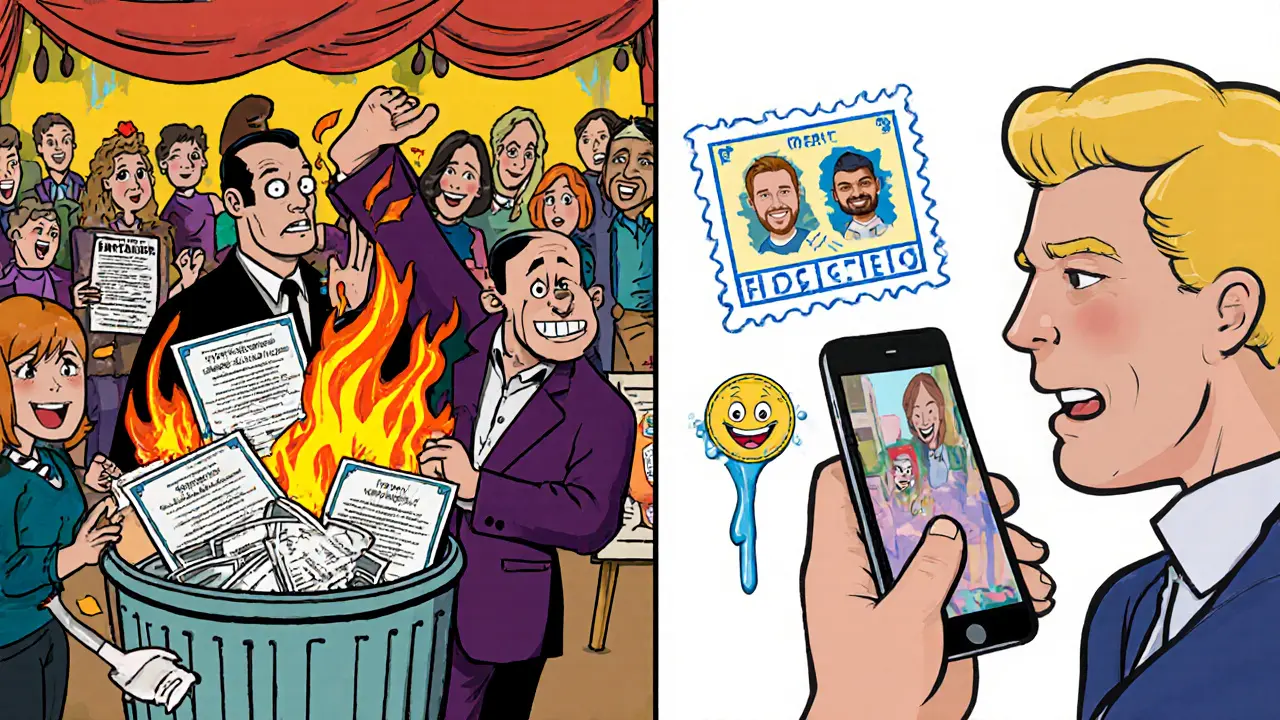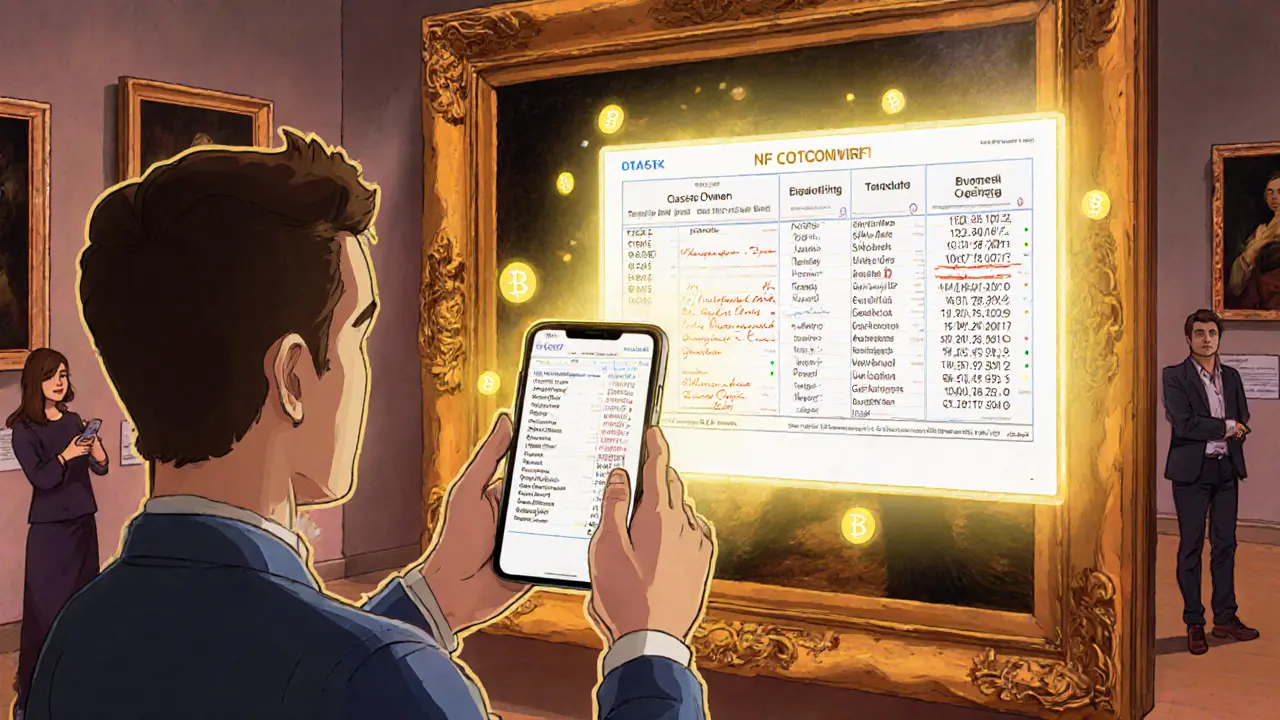NFT Art Minting Cost Calculator
Estimated Costs
Gas Fee Alert: Ethereum fees can spike during high network demand. Current estimates show prices may increase by 200-300% during peak times.
Based on article data: Polygon ($1-$20), Ethereum ($10-$50), Solana ($0.01-$0.50). Actual costs vary with network congestion.
Imagine buying a painting at an auction, paying $50,000, and later finding out it’s a fake. Not a copy - a full forgery, with a forged certificate to match. This isn’t rare. The global art market loses an estimated $6 billion every year to fraud. Now, picture a system where you can scan a tiny chip on the back of that painting with your phone, and instantly see every owner since the artist made it - all recorded on a public, unchangeable ledger. That’s not science fiction. It’s happening today, using NFTs.
What NFTs Actually Do for Art
NFTs aren’t the artwork itself. They’re digital certificates tied to it. Think of them like a birth certificate for a piece of art - but one that’s stored on a blockchain, not in a drawer somewhere. Unlike Bitcoin or Ethereum, which are interchangeable (one Bitcoin is the same as another), NFTs are one-of-a-kind. Each holds unique data: who made it, when, who owned it, and how it was verified.
This matters because traditional paper certificates can be forged, lost, or stolen. A fake certificate with a real painting? That’s a common scam. NFTs fix that. Once a certificate is minted on a blockchain, it can’t be altered. No one can change the ownership history. No one can delete it. Even if someone steals the physical painting, the NFT stays with the rightful owner.
Most NFT art authentication runs on Ethereum, which still holds 72% of the market as of mid-2025. But cheaper chains like Solana and Polygon are catching up, especially for artists who don’t want to pay $50 in gas fees just to prove their work is real.
How Physical Art Gets Verified with NFTs
What if your art isn’t digital? What if it’s an oil painting on canvas? That’s where things get clever. Artists and galleries now embed physical verification tools right into the artwork.
- QR Codes: Hidden under the frame or on the back, these link to the NFT’s blockchain record. Scan with your phone - no app needed. You’ll see the artist’s name, creation date, and every past sale.
- NFC Chips: Tiny, coin-sized chips embedded in the backing. Tap your phone to them (like Apple Pay), and encrypted data pops up. These chips are tamper-proof - if someone tries to remove or replace them, the system flags it.
- Digital Watermarks: Invisible patterns hidden in the image file itself. Only detectable with special apps, they’re used for high-value pieces. Some newer versions, like those from VeriArt (March 2025), even include biometric data tied to the artist’s fingerprint.
These methods don’t replace the physical art. They anchor it to the blockchain. So if you own a painting with an NFC chip, and someone tries to sell you a copy, your phone will show the original NFT’s history - proving it’s the real one.
Why This Beats Old-School Certificates
Before NFTs, authentication relied on:
- Hand-signed paper certificates (easily forged)
- Gallery records (lost in fires or bankruptcies)
- Expert opinions (subjective, expensive, and slow)
NFTs change all that. Here’s how:
| Feature | Traditional Certificate | NFT-Based Verification |
|---|---|---|
| Forgery Risk | High - paper can be copied | Near zero - blockchain is immutable |
| Ownership Proof | Depends on trust | Public, verifiable by anyone |
| Transfer Process | Manual paperwork, delays | Automated via smart contract |
| History Access | Only if gallery keeps records | Complete chain visible online |
| Cost to Verify | $200-$2,000 per expert appraisal | Free - scan with your phone |
A 2024 Verifyed.io survey found 92% of collectors who used QR or NFC verification felt confident in their purchase. One Reddit user, u/ArtCollector87, wrote: “I bought a piece with an NFC chip. At the gallery, I tapped my phone - and saw it was owned by three collectors before me, including the artist. That’s peace of mind you can’t buy.”
How Artists Set It Up
If you’re an artist, here’s what you actually need to do:
- Create a digital wallet (MetaMask, Phantom, or Trust Wallet).
- Upload your artwork to an NFT platform (OpenSea, Foundation, or SuperRare).
- Mint the NFT - this costs a fee (gas), usually $1-$20 on Polygon, $10-$50 on Ethereum.
- Link your NFT to a physical verification method: embed an NFC chip, print a QR code, or add a digital watermark.
- Store the private key safely. Lose it, and you lose control of your NFT.
Artists who already work digitally need about 10-15 hours to learn the process. Traditional painters unfamiliar with tech might need 25-40 hours. The good news? Platforms like OpenSea offer 127-page guides. Reddit and Discord communities are full of people willing to help.
But here’s the catch: 43% of NFT thefts happen because people lose their private keys or fall for phishing scams. If someone tricks you into giving away your recovery phrase, they own your art - and your NFT - forever. There’s no customer service to call.
What the Experts Say - And What They Disagree On
Not everyone agrees NFTs should replace human expertise. Blockchain purists argue: “The code is the truth.” But top art authentication labs say otherwise.
Technologies like infrared imaging and X-ray radiography still matter. They can reveal hidden sketches, overpainting, or changes in materials - things a blockchain can’t detect. Dr. Emily Watson, an art historian quoted in ArtForum, put it bluntly: “Blockchain verifies digital ownership records. It doesn’t tell you if the brushstrokes match the artist’s style from 1947.”
Industry leaders now recommend a hybrid approach:
- Use NFTs for immutable ownership records.
- Use experts for physical analysis of technique, materials, and history.
- Use AI to cross-check brush patterns or pigment composition against known works.
That’s why Christie’s, Sotheby’s, and 41 of the top 100 galleries globally now use NFT authentication - not to replace their experts, but to give them better tools. The Universal Art Authentication Protocol (UAAP), launched in January 2025, is pushing for standardized verification across platforms.

Real-World Examples
It’s not just artists. Luxury brands are using this too. Louis Vuitton’s 2023 “LV Vault” collection embeds NFC chips in handbags. Scan it, and you see the item’s entire journey - from factory to customer. No fake bags. No resale fraud.
Even governments are paying attention. The EU’s MiCA regulation, effective December 2024, requires NFT marketplaces to verify user identities. That means platforms now do KYC (Know Your Customer) checks - reducing money laundering and making the market safer for collectors.
Challenges Still Left to Solve
This isn’t perfect. Here’s what’s still broken:
- Smartphone Compatibility: Not all phones read NFC chips. Older iPhones and budget Androids often don’t support it.
- Gas Fees: Ethereum’s fees spike during sales. A $10 mint could become $80 overnight.
- Legacy Art: What about a 1920s painting with no digital record? NFTs can’t retroactively verify it - unless you mint a new certificate and get the family to sign off.
- Education Gap: 68% of collectors over 55 struggle with setting up wallets. The tech is simple - but the mindset isn’t.
And then there’s energy. Ethereum used to be criticized for its carbon footprint. But after its 2022 merge, energy use dropped by 99.95%. Today, minting an NFT uses less power than sending an email.
What’s Next?
Gartner predicts 75% of high-value art sales will use blockchain verification by 2027. That’s not a guess - it’s based on adoption trends. The technology isn’t replacing appraisers. It’s giving them a digital backbone.
For collectors, it means confidence. For artists, it means control. For the market, it means trust.
As of 2025, NFTs for art authentication are no longer a trend. They’re the new standard - for digital art, for physical art, and for the future of how we prove what’s real.
Can I verify an NFT artwork without a smartphone?
Yes, but it’s harder. You can check ownership on a computer by visiting the NFT’s page on a blockchain explorer like Etherscan or Solana Explorer. You’ll need the NFT’s contract address or token ID. But for physical art with QR codes or NFC chips, a smartphone is required - those methods are designed for instant, on-the-spot verification.
Are NFTs the only way to stop art forgery?
No. Traditional methods like infrared imaging, pigment analysis, and expert connoisseurship still play a vital role - especially for older or high-value works. NFTs don’t replace experts; they give them a tamper-proof digital ledger to reference. The strongest authentication combines both: human insight backed by blockchain data.
What happens if I lose my NFT wallet password?
You lose access permanently. There’s no “forgot password” button on a blockchain. Your wallet is secured by a private key - a long string of letters and numbers. If you don’t back it up safely, no one - not even the platform - can recover it. That’s why most serious collectors use hardware wallets like Ledger or Trezor, which store keys offline.
Do I own the artwork if I buy its NFT?
Not necessarily. Buying an NFT usually gives you proof of ownership of the digital token - not the copyright or reproduction rights. The artist typically keeps those unless explicitly transferred in the smart contract. Always check the terms before buying. Some NFTs include commercial rights; most don’t. The NFT proves you own that specific copy - not the right to print or sell copies.
Can I authenticate a painting I inherited?
Yes, but it takes work. You’d need to commission a professional to verify its authenticity using traditional methods (expert analysis, imaging, etc.). Once confirmed, you can mint an NFT linking to that verification report. Then, you can embed a QR code or NFC chip on the frame. This creates a new, verifiable chain of ownership from you forward - but it doesn’t rewrite the past. The NFT only records what happens after it’s created.
Is NFT art authentication legal?
Yes, and increasingly regulated. In the EU, MiCA requires NFT marketplaces to verify users’ identities (KYC) and prevent money laundering (AML). In the U.S., the IRS treats NFTs as property, so sales are taxable. Legally, NFTs are recognized as valid proof of ownership in many jurisdictions. But they’re not a magic shield - if you buy a stolen artwork, even with an NFT, you may still lose it in court if the original owner proves theft.
For artists and collectors alike, NFT authentication isn’t about chasing hype. It’s about building trust in a market that’s long been broken. The tools are here. The data is clear. The question isn’t whether it works - it’s whether you’re ready to use it.
